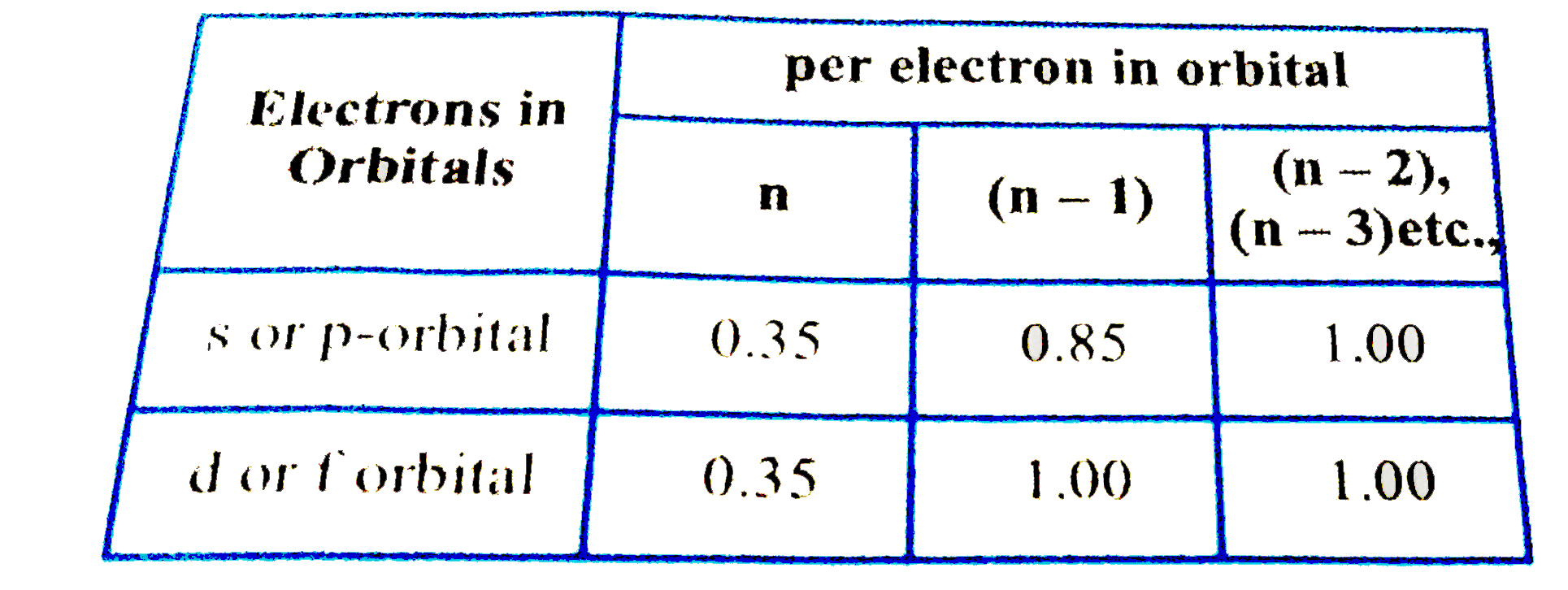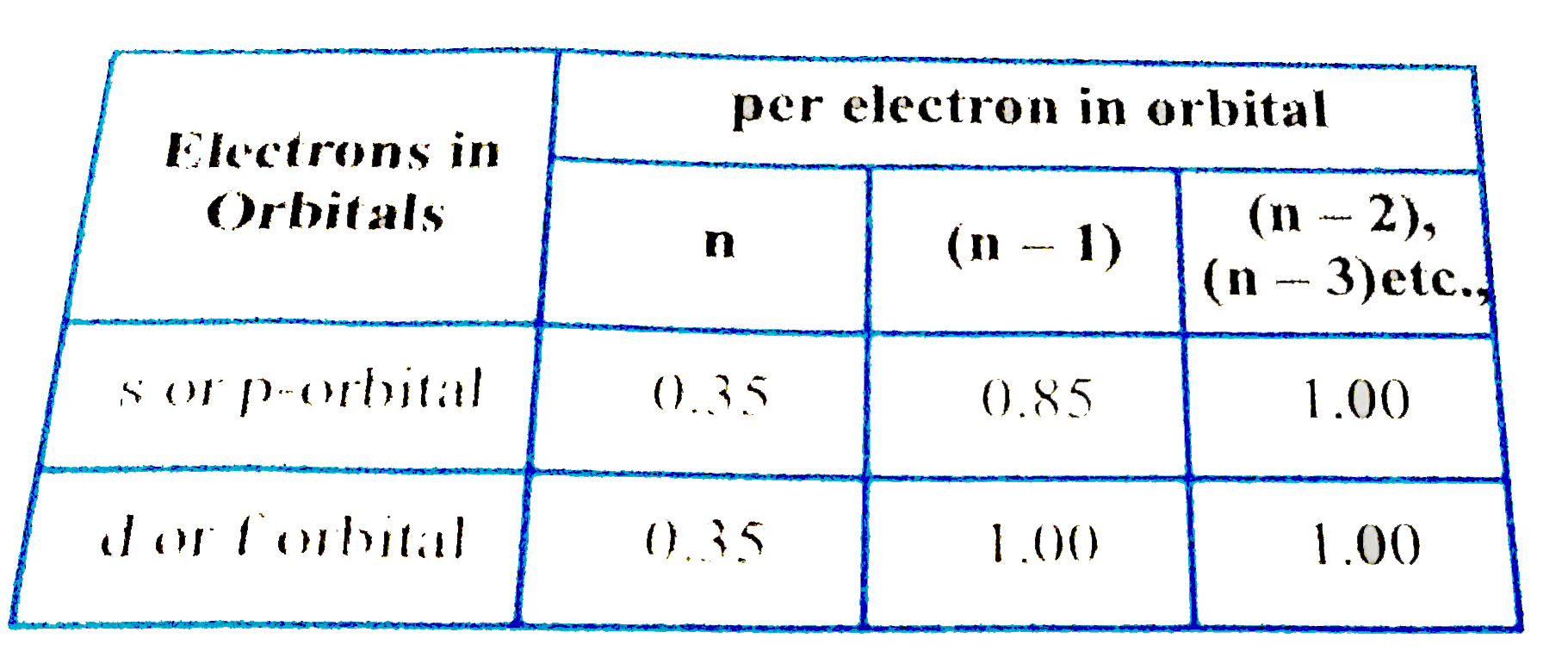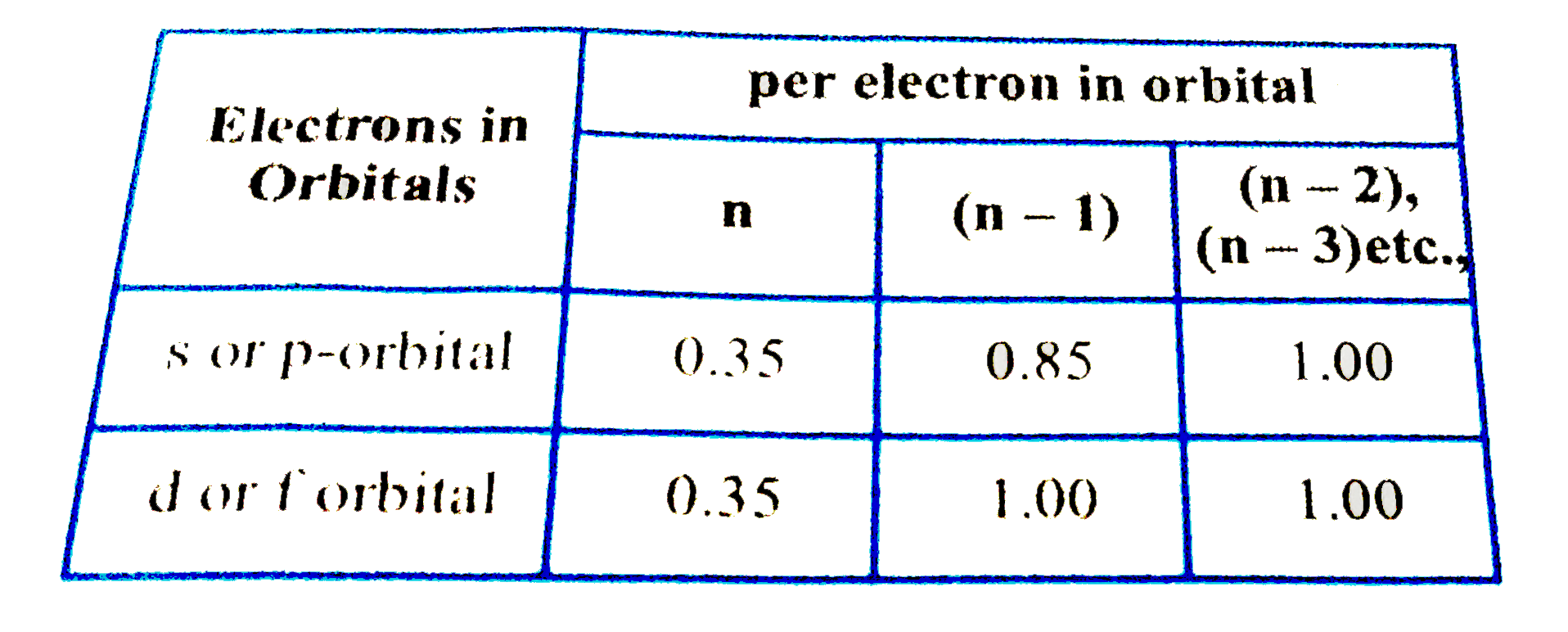Nuclear charge actually experienced by an electron is termed as effective nuclear charge. The effective nuclear charge Z∗ actuall ydepends on type of shell and orbital in which electron is actually present. The relative extent to which the various orbitals penetrate the electron clouds of other orbitals is
s>p>d>f (for the same value of n)
The phenomenon in which penultimate shell electrons act as screen or sheild in between nucleus and valence shell electrons and thereby reducing nuclear charge is known as shielding effect. the penultimate shell electrons repel the valence shell electron to keep them loosely held with nucleus. it is thus evident that more is the shielding effect, lesser is the effective nuclear charge and lesser is the ionization energy.
Q. Which of the following valence electron experience maximum effective nuclear charge?
4s1
4p1
3d1
2p3
The correct Answer is:D
Electrons closer to nucleus will experience higher effective nuclear charge. 2p3 is closer to 4s1 as principal quantum number is concerned first.
Topper's Solved these Questions
- PERIODIC PROPERTIESBOOK - VK JAISWALCHAPTER - PERIODIC PROPERTIESEXERCISE - ONE OR MORE ANSWERS IN/ARE CORRECT
99 Videos
- PERIODIC PROPERTIESBOOK - VK JAISWALCHAPTER - PERIODIC PROPERTIESEXERCISE - MATCHTHE COLUMN
5 Videos
- p-BLOCK ELEMENTSBOOK - VK JAISWALCHAPTER - p-BLOCK ELEMENTSEXERCISE - SUBJECTIVE PROBLEMS
36 Videos
- QUALITATIVE INORGANIC ANALYSISBOOK - VK JAISWALCHAPTER - QUALITATIVE INORGANIC ANALYSISEXERCISE - SUBJECTIVE PROBLEMS
5 Videos
Similar Questions
Assign the position of the element having outer electronic configuration,
(A) ns2np2 (n=6)
(B) (n−1)d2ns2 (n=4)
(C) (n−2)f7(n−1)d−1ns2 (n=6)
Which of the following statement(s) is/are correct?
View Solution
View SolutionIn phosphorus acid, If X is number of non-bonding electron pairs. Y is number of σ-bonds and Z is number of π-bonds. Then calculate value of "YxZ-X".
View SolutionConsider the following reaction

Then calculate value of ∣∣X2−Y2∣∣ (where X and Y are total number of electrons present t_(2g) and e_(g) orbitals respectively in d-block metal ion of compound B).
View SolutionNuclear charge actually experienced by an electron is termed as effective nuclear charge The effective nuclear Z∗ actually depends on type of shell and orbital in which electron is actually present. The relative extent to which the various orbitals penetrate is .s>p>d>f (for the same value of n)
The phenomenon in which penulitmate shell electrons act as screen or shield in between nucleus adn valence shell electrons and there by reducing nuclear charge is known as sheilding effect. The penultimate shell electrons repel the valence shell electron to keep them loosely held with nucleus . It is thus evident that more is the shielding effect, lesser is the effective nuclear charge and lesser is the ionizatio energy.
Which of the following is not concerned to effective nuclear charge?
View SolutionNuclear charge actually experienced by an electron is termed as effective nuclear charge The effective nuclear Z∗ actually depends on type of shell and orbital in which electron is actually present. The relative extent to which the various orbitals penetrate is .s>p>d>f (for the same value of n)
The phenomenon in which penulitmate shell electrons act as screen or shield in between nucleus adn valence shell electrons and there by reducing nuclear charge is known as sheilding effect. The penultimate shell electrons repel the valence shell electron to keep them loosely held with nucleus . It is thus evident that more is the shielding effect, lesser is the effective nuclear charge and lesser is the ionizatio energy.
Ionization energy is not influenced by :
View SolutionAccording to I.C slater effective nuclear charge, Z∗, due to screening, is not exactly equal to the actual nuclear charge Z of the nucleus of the atom. Z∗ depends on the type of orbitals in which the electron is housed, and on the ability of other electrons in more penetrating orbitals to screen the electron in question from the nucleus.
The relative extent to which the various orbitals penetrate the electron clouds of other orbitals is s>p>f . The effective nuclear charge Z∗ due to screening is given by Z∗=Z−σ, where Z is the atomic atomic number and σ is the slater screening constant values 0<σ<Z

Screening effect of one electron in the outermost orbitals, is not considered in calculate of σ.
What is the value of Z∗ for Rb(37) ?
View SolutionAccording to I.C slater effective nuclear charge, Z∗, due to screening, is not exactly equal to the actual nuclear charge Z of the nucleus of the atom. Z∗ depends on the type of orbitals in which the electron is housed, and on the ability of other electrons in more penetrating orbitals to screen the electron in question from the nucleus.
The relative extent to which the various orbitals penetrate the electron clouds of other orbitals is s>p>f . The effective nuclear charge Z∗ due to screening is given by Z∗=Z−σ, where Z is the atomic atomic number and σ is the slater screening constant values 0<σ<Z

Screening effect of one electron in the outermost orbitals, is not considered in calculate of σ.
what is Z∗ for Cu(29) ?
View SolutionNuclear charge actually experienced by an electron is termed as effective nuclear charge The effective nuclear Z^(**) actually depends on type of shell and orbital in which electron is actually present. The relative extent to which the various orbitals penetrate is . s gt p gt d gt f (for the same value of n) The phenomenon in which penulitmate shell electrons act as screen or shield in between nucleus adn valence shell electrons and there by reducing nuclear charge is known as sheilding effect. The penultimate shell electrons repel the valence shell electron to keep them loosely held with nucleus . It is thus evident that more is the shielding effect, lesser is the effective nuclear charge and lesser is the ionizatio energy. In which of the following valence electron experience maximum effective nuclear charge?
View SolutionAccording to I.C slater effective nuclear charge, Z^(**) , due to screening, is not exactly equal to the actual nuclear charge Z of the nucleus of the atom. Z^(**) depends on the type of orbitals in which the electron is housed, and on the ability of other electrons in more penetrating orbitals to screen the electron in question from the nucleus. The relative extent to which the various orbitals penetrate the electron clouds of other orbitals is s gt p gt f . The effective nuclear charge Z^(**) due to screening is given by Z^(**)=Z-sigma , where Z is the atomic atomic number and sigma is the slater screening constant values 0 lt sigma lt Z Screening effect of one electron in the outermost orbitals, is not considered in calculate of sigma . What is the value of Z^(**) for Rb(37) ?
View SolutionAccording to I.C slater effective nuclear charge, Z∗, due to screening, is not exactly equal to the actual nuclear charge Z of the nucleus of the atom. Z∗ depends on the type of orbitals in which the electron is housed, and on the ability of other electrons in more penetrating orbitals to screen the electron in question from the nucleus.
The relative extent to which the various orbitals penetrate the electron clouds of other orbitals is s>p>f . The effective nuclear charge Z∗ due to screening is given by Z∗=Z−σ, where Z is the atomic atomic number and σ is the slater screening constant values 0<σ<Z

Screening effect of one electron in the outermost orbitals, is not considered in calculate of σ.
In which of the following cases the concept of Z∗ is applicable?
View SolutionNuclear charge actually experienced by an electron is termed as effective nuclear charge. The effective nuclear charge Z∗ actuall ydepends on type of shell and orbital in which electron is actually present. The relative extent to which the various orbitals penetrate the electron clouds of other orbitals is
s>p>d>f (for the same value of n)
The phenomenon in which penultimate shell electrons act as screen or sheild in between nucleus and valence shell electrons and thereby reducing nuclear charge is known as shielding effect. the penultimate shell electrons repel the valence shell electron to keep them loosely held with nucleus. it is thus evident that more is the shielding effect, lesser is the effective nuclear charge and lesser is the ionization energy.
Q. Which of the following valence electron experience maximum effective nuclear charge?
View SolutionNuclear charge actually experienced by an electron is termed as effective nuclear charge. The effective nuclear charge Z∗ actuall ydepends on type of shell and orbital in which electron is actually present. The relative extent to which the various orbitals penetrate the electron clouds of other orbitals is
s>p>d>f (for the same value of n)
The phenomenon in which penultimate shell electrons act as screen or sheild in between nucleus and valence shell electrons and thereby reducing nuclear charge is known as shielding effect. the penultimate shell electrons repel the valence shell electron to keep them loosely held with nucleus. it is thus evident that more is the shielding effect, lesser is the effective nuclear charge and lesser is the ionization energy.
Q. Ionzation enegy is not influenced by:
View SolutionNuclear charge actually experienced by an electron is termed as effective nuclear charge. The effective nuclear charge Z∗ actuall ydepends on type of shell and orbital in which electron is actually present. The relative extent to which the various orbitals penetrate the electron clouds of other orbitals is
s>p>d>f (for the same value of n)
The phenomenon in which penultimate shell electrons act as screen or sheild in between nucleus and valence shell electrons and thereby reducing nuclear charge is known as shielding effect. the penultimate shell electrons repel the valence shell electron to keep them loosely held with nucleus. it is thus evident that more is the shielding effect, lesser is the effective nuclear charge and lesser is the ionization energy.
Q. Which of the following is not concerned to effective nuclear charge?
View SolutionNuclear charge actually experienced by an electron is termed as effective nuclear charge. The effective nuclear charge Z∗ actuall ydepends on type of shell and orbital in which electron is actually present. The relative extent to which the various orbitals penetrate the electron clouds of other orbitals is
s>p>d>f (for the same value of n)
The phenomenon in which penultimate shell electrons act as screen or sheild in between nucleus and valence shell electrons and thereby reducing nuclear charge is known as shielding effect. the penultimate shell electrons repel the valence shell electron to keep them loosely held with nucleus. it is thus evident that more is the shielding effect, lesser is the effective nuclear charge and lesser is the ionization energy.
Q. Ionzation enegy is not influenced by:
View Solution
